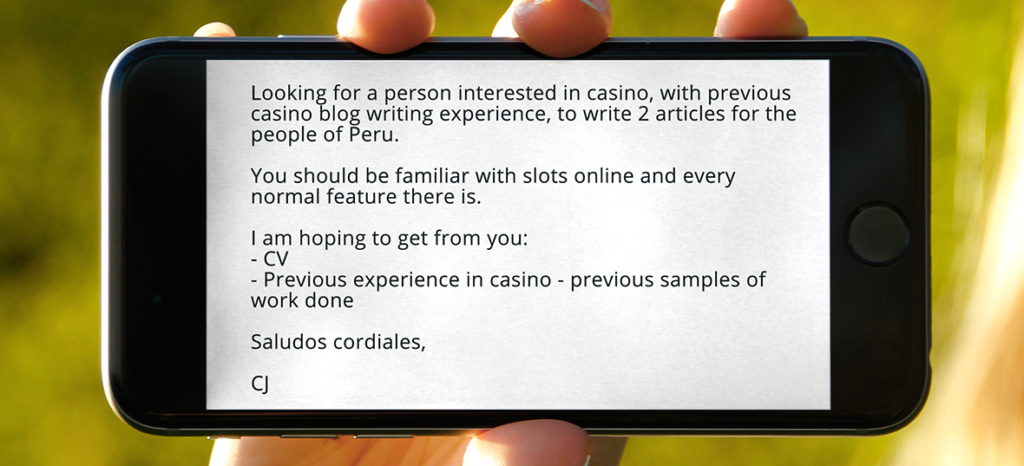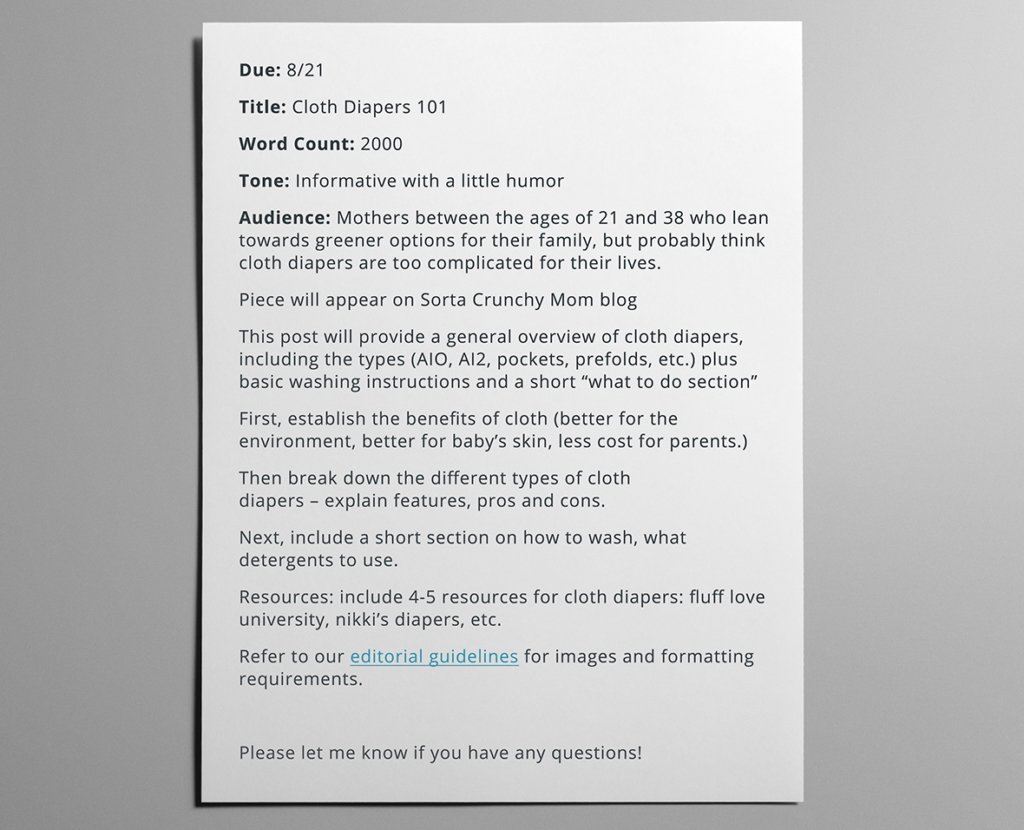Now that every brand and company is looking for a process to create and publish owned content, many are in a position to need writers and other creatives (web designers, photographers, social media specialists). Whether your company is hiring an in-house team, engaging an agency or hiring consultants/freelancers, there will be a learning curve as the new creatives learn about your brand and its needs.
Unless you are hiring someone you’ve worked with for many years, who understands your industry inside-out and can pick up brand style instantly, you will probably need to supply parameters and ideas for what you want written, designed and produced. Since a lot of brand managers don’t know right off the bat, or are in a hurry to get this new and burdensome content project off their plate, the impulse may be to give very minimal instructions — i.e., a list of venues that need to be covered, or “Please give me 10 blogs about the beauty industry.” Even for the most willing writer or designer, that’s probably not enough information.
Looking at a general content need from the broadest perspective — the first thing to explain is, what message or story do you want this content to communicate? What is its intended purpose? From there, what are the company brand voice guidelines that will apply to this assignment? How long would you like it to be? The more detailed you get with your parameters, the better you guide the freelancer. The document that contains all this instruction is referred to as the creative brief, writer’s brief, outline or sometimes, simply “the assignment.”
We asked several professionals who have been on both sides of the fence how they create briefs or assignments, and what’s worked for them in the past when working with companies. Let’s dive into how to format a writer’s assignment and best practices
Why do you need a brief/assignment?
“Creative briefs are critical to ensuring that your project conveys the correct message,” says Sonia Diaz, VP at Balsera Communications. As a public affairs and communications strategy firm for politicians, unions and major corporations, Balsera has to be very conscious and precise with messaging at all times – and more than that, make sure the messaging is consistent across multiple languages.
As many brands switch to using platforms instead of agencies, brand managers often have to craft briefs themselves instead of relying on agency professionals. The results can be dramatically different. Here is an assignment brief from a popular freelancing platform. It is sparse.
It provides virtually no details, no word count. I can’t even tell if this article is for an English or Spanish audience, or how it would relate to the people of Peru. Most people could not know for sure whether they would be a good fit for this gig based on the information provided.
Now, let’s look at an example of a detailed brief/assignment.
This concept provides exactly what the writer needs in order to know whether they should raise their hand for the assignment. And if they do so, it’s with a good-faith guarantee that they can produce an excellent, on-message piece of content. You have the word count, the goal of the post, where the post will be published, what tone to use — even an outline to get the writer started. When a project manager assigns a writer something using this type of brief, they should expect a fairly clean first draft.
Elements that should be included in a brief or assignment
1. Content type
What type of content do you want to create — a blog post? A white paper? Press release? Product description?
2. The target audience
Providing the target audience helps the writer create a personalized piece of content.
The language used in an article aimed at a CMO is much different than the language you would use for a millennial consumer in the middle household income range. When defining the target audience, consider building out a persona (aka avatar) that includes the target’s age, gender, interests, job title, income, needs, and affinity to your product/service. This helps the writer know what tone and approach to take.
Meredith Hoffa, who edits the online magazine of a popular mom’s humor brand, always gives a few differentiators between her website’s POV and other similar sites out there.
“I tell writers I want their stories to be voice-driven but grounded in reality. I want them to let loose, but not lose their humanity in trying to be funny or jokey. The funny should serve the spine of the story. Readers should read the piece and come away thinking ‘I want to be best friends with that author.’”
3. The goal
What is the purpose of your article? The takeaway? What problem does it solve or what action do you want the reader to take?
“To ensure that your team is properly translating your vision, it is important you have defined certain aspects of the project, such as, ‘Who is my audience?’ and ‘What is the feeling you want people to get when they see your product or read your slogan or piece?’” Sonia from Balsera says. “These factors will help in deciding appropriate language, format, font type and tone, to name a few.”
This information helps the writer craft a piece of content that does what you want it to do and is on message with your brand.
4. Company style guidelines
“We don’t always know the nuances of every business we write about, such as who the competitors and what the no-go topics are,” says content consultant Bob Curley, whose clients range from Healthline to Business Traveller to Disney (one of the most rigorously controlled brands of all time). He prefers assignments to contain less creative direction, but plenty of detailed instruction on company style and branding guidelines.
“For case studies, a key element of a brief would be the brand style and language. What words should I use to describe clients and the institution and its partners? Also, as someone coming from outside the organization it’s helpful to know what the vernacular is in terms of describing people’s jobs and titles.”
5. Where the piece will be published
In the online casino example above, and equally as much for the corporate assignments that Bob Curley often gets, the ultimate destination for this piece of content matters a great deal. Larger corporations often want slightly different tone and language for different types of content: An easy example would be to compare a brand’s social media accounts with its corporate About Us section. Even if writing a typical “magazine-style article,” a writer would need to know whether it’s for a blog and should include internal/outbound links, or whether it’s for publication in print, or will be published on a third party site.
Sharing where the article will be published also allows the writer to research the tone and feel of the site.
6. Key performance indicators
This element of the brief is new to people who come from editorial, and even some PR agencies don’t include it, though many do. Marketers, though, tend to find the KPIs the missing piece and most easy to way to gauge whether a content initiative has worked for their brand. The key is to define what those KPIs are, since it typically isn’t direct sales (although sometimes it can be) or even page views.
We should always be thinking, “How is this content going to funnel, or flywheel my reader into being an active customer or advocate?” says Kate Madonna-Hindes, who owns the content marketing agency Girl Meets Geek and has worked for major brands like Home Depot and AMEX. “If we’re thinking from the end-game, (conversion) we write to convert.”
So what does conversion look like for a marketer or brand manager? That depends. It could be newsletter signups or form submissions. It could be requests for more information. It could be traffic driven to the reservations page. It could be page views, or what many people consider more valuable these days: return visits to your site.
“To gauge if content is successful, page views don’t always tell the story. It’s wise to use Google’s heat-mapping to see what they are doing while on the page,” says Kate.
If you’re doing this, you may want to instruct your writer to include a certain number of internal and outbound links, a place for an infographic or poll, and a prompt to share their email address for newsletter content or contact from a company representative.
7. Topic or content directions — more detail is better
Your outline should provide the writer with any messaging or story points you definitely want covered. It could include the geographical region of your audience. Also, it should convey the publication and/or company’s preferred tone, POV and any keywords you want to include.
Meredith Hoffa gives specific no-go parameters that writers who specialize in women’s lifestyle content would not necessarily know the first time they wrote for her publication: “I tell them what things to avoid — things I know my brand hates, like the ‘we got you’ trope and the ‘moms, let’s stop judging other moms!’ trope,” she says.
She also places a lot of emphasis on distilling the theme/angle of the piece into a catchy headline.
“Headline idea: No to clickbait, but yes to an active header that grabs the reader. What makes someone want to click this article on social media or in one of our newsletters?
“So much about this type of content is in the packaging. If their piece can’t be summed up in a snappy headline, then it won’t work.”
8. Contact names and info
Many times in branded content, the writer will be expected to reach out to specific sources for quotes or full interviews. If you have those people in mind, include their names, roles and how to get in touch with them. Also include other parameters If applicable, for example: “Email to request an interview, and if you don’t hear back, follow up at the end of the week.”
Since the sources for brand stories can range from factory floor employees to the CEO, it’s crucial to support a freelancer by at least telling them how to get in touch with the sources, if not actually making the connections for them.
9. Due date
This one is self-explanatory.
10. Word count requirements
Give the writer a minimum and, if there is one, a maximum word count. Consider adding 100 words or so to your actual word count requirement. It’s easier to cut the fluff during editing than have to go back and ask for more detail or more straight-up meat to the piece.
11. Links to other relevant documents
If you hire writers often, you should create contributor guidelines and a company style guide. Make sure to include links to these documents in your brief/assignment.
Finally, if you have any reference URLs or favorite blog posts that you want to emulate, include links to those as well.
Great content doesn’t have to be a headache to produce
If you think content strategy is annoying to begin with, it becomes exponentially more frustrating and time-consuming if you have to spend hours answering freelancer emails, requesting revisions, or reworking content that wasn’t on point. This wastes your time, stretches your budget thinner, and makes the creative freelancers (who may have excellent skills and all the good will in the world) grow insecure or resentful. And it’s exactly what you risk when you send a writer off with one sentence to describe what you want.
Stellar development begets stellar content. Empower your writer with the tools and information they need to produce the engaging, brand-elevating, helpful content your audience wants. And if you’d rather outsource to a trusted partner, connect with us at ClearVoice. Our managed content creation and expert creators will help you produce high-quality content that accomplishes your bran mission.










